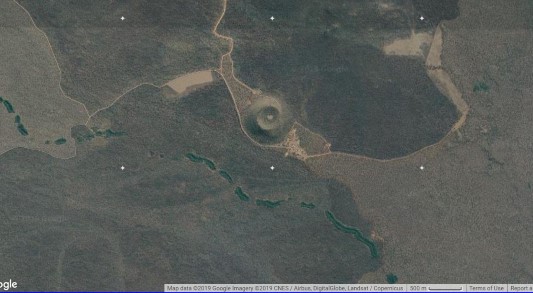Not enough to make the surface greasy. Though 4wd helped through some parts.
Definitely not enough sun for the solar to recharge batteries.
Which reminded me of many years ago talking to a farmer in central Zambia who was delighted after 30 years of trying to have succeeded in growing grass.
And knocked the congealed, dried, mud off the exhaust pipe. A down side of having changed from vertical behind the cab to out the side.
We didn't get as far as the basalt wall marked on one of our maps. And couldn't see Boomerang Crater through the trees.
This is from the top of Kalkani Crater. Another scoria cone. We walked around the rim ... because we could. Nice was the 600m steady inclined track that traversed the cone to the rim, a fast walk got the heart and lungs working. Ever conscious of health these days its been nice to be a bit more free of PMR symptoms since we left home and walked lots. Feeling like its time to reduce the medication another small step. Most of our walks so far have been "gentle", though walking up out of Porcupine Gorge challenged the leg muscles.
Inaccessible to us as the Undara Resort has a monopoly on access and provides guided tours. We don't really like guided tours as we can't remember what is said for very long and there's usually not much information that's of use to us. We know how lava tubes are formed. More importantly, the idea of a pay wall between us and nature is anathema. We dislike rent seeking on principle. Booking and a timetable seem all too hard.
Undara is a shield volcano, the basalt oozed over a very wide area, extending 25km from the source.

The roads are clear to see - it looks like there has been a large temporary "village" to the NW of the crater. Looks like there has been some prospecting activity.
The ranger station (Yarama) is SE of the crater. The track from there SE to the main road seems to not exist.
The gaps in the lines of dark green trees are easier to see. Like somone has been sewing. As is the track to one of the cave entrances. Magnified there's a turn around spot.
Just before the lookout was this rather odd (to us) sign. The resort is about 1km back along our track.
The track beyond the sign looks like it gets very little use. Perhaps explained by it not appearing on the map at the resort (which, as we always do, we took a pic of before we set out).
Not to the caravan park, we kept moving along Nymbool Road and camped for the night just short of Nymbool. Next to a pleasant creek.
Much more familiar was the sound (and sight) of a flock of crimson rosellas.
We are yet again camped about the middle of the Great Dividing Range. More by luck than design we seem to be following it northwards. If it wasn't marked on the map we wouldn't know.